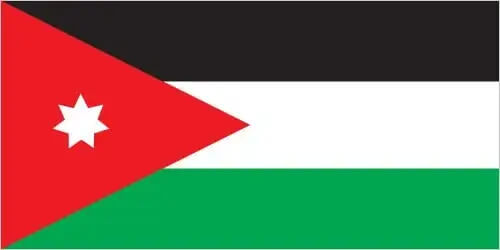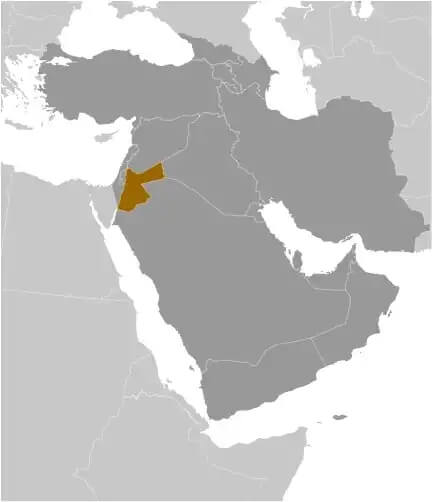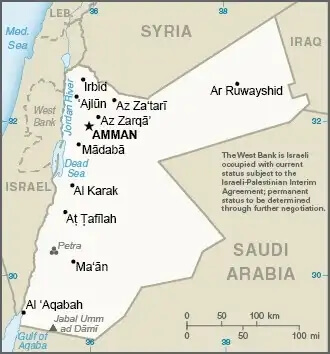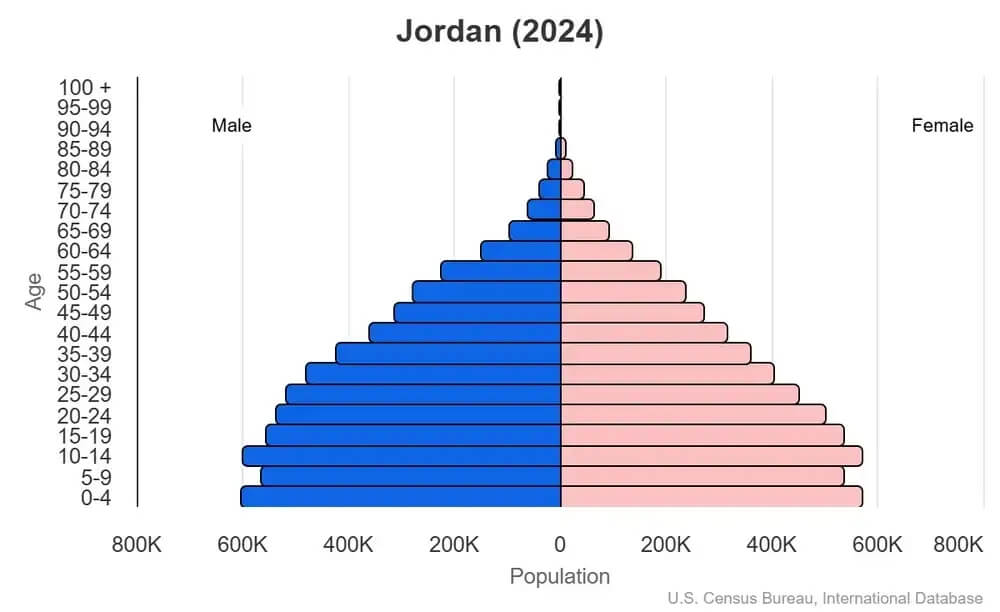World Book
Jordan
World Book Index
59


With a score of 59, the country is ranked 104th out of 158 countries in the World Book ranking. (more information)
Introduction
Background
After World War I and the dissolution of the Ottoman Empire, the League of Nations awarded Britain the mandate to govern much of the Middle East. In 1921, Britain demarcated from Palestine a semi-autonomous region of Transjordan. The area gained its independence in 1946 and thereafter became the Hashemite Kingdom of Jordan.
Geography
Area
total : 89,342 sq km
land: 88,802 sq km
water: 540 sq km
Climate
mostly arid desert; rainy season in west (November to April)
Natural resources
phosphates, potash, shale oil
People and Society
Population
total: 11,174,024 (2024 est.)
Ethnic groups
Jordanian 69.3%, Syrian 13.3%, Palestinian 6.7%, Egyptian 6.7%, Iraqi 1.4%, other 2.6% (2015 est.)
Languages
Arabic (official), English (widely understood among upper and middle classes)
Religions
Muslim 97.1% (official; predominantly Sunni), Christian 2.1% (majority Greek Orthodox, but some Greek and Roman Catholics, Syrian Orthodox, Coptic Orthodox, Armenian Orthodox, and Protestant denominations), Buddhist 0.4%, Hindu 0.1%, Jewish <0.1%, folk <0.1%, other <0.1%, unaffiliated <0.1% (2020 est.)
Population growth rate
0.78% (2024 est.)
Government
Government type
parliamentary constitutional monarchy
Capital
name: Amman
Executive branch
chief of state: King ABDALLAH II (since 7 February 1999)
head of government: Prime Minister Jafar HASSAN (since 15 September 2024)
Diplomatic representation in the US
chief of mission: Ambassador Dina Khalil Tawfiq KAWAR (since 27 June 2016)
Diplomatic representation from the US
chief of mission: Ambassador (vacant); Chargé d’Affaires Peter T. SHEA (since 29 June 2025)
Economy
Economic overview
upper-middle-income Middle Eastern economy; high debt and unemployment, especially for youth and women; global events triggering trade slump and decreased revenue from tourism; growing manufacturing and agricultural sectors; key US foreign assistance recipient; natural-resource-poor and import-reliant
Real GDP (purchasing power parity)
$109.986 billion (2024 est.)
$107.315 billion (2023 est.)
$104.307 billion (2022 est.)
Real GDP per capita
$9,500 (2024 est.)
$9,400 (2023 est.)
$9,300 (2022 est.)
Exports
$22.186 billion (2023 est.)
$20.743 billion (2022 est.)
$13.87 billion (2021 est.)
Exports - partners
USA 21%, India 13%, Saudi Arabia 11%, China 7%, Iraq 6% (2023)
Exports - commodities
fertilizers, garments, phosphates, jewelry, phosphoric acid (2023)
Imports
$28.922 billion (2023 est.)
$30.019 billion (2022 est.)
$23.321 billion (2021 est.)
Imports - partners
China 17%, Saudi Arabia 14%, UAE 8%, India 6%, USA 5% (2023)
Imports - commodities
cars, refined petroleum, gold, crude petroleum, jewelry (2023)
Human Development Index
The country's Human Development Index (HDI) is 0.754, ranking it 100th out of 193 countries tested. (more information)
World Happiness Report
The World Happiness Report ranked the country 122nd out of 158 countries tested with a score of 4.377. (more information)



